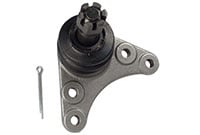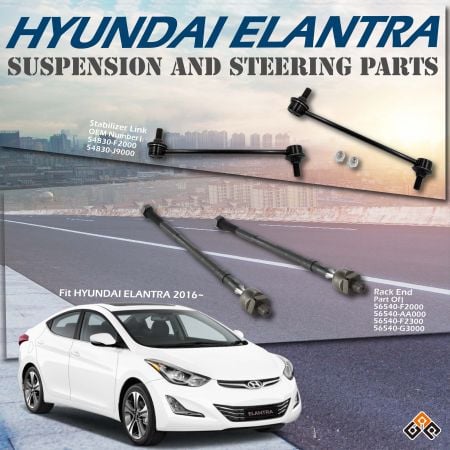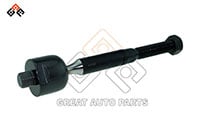What Causes Tie Rods to Wear Out Quickly and How to Maintain Them
If you’ve been driving your car for a while, you probably understand the importance of keeping all its parts in top condition. Among the many components in your car that you rely on every day, tie rods are one of the unsung heroes. Without them, steering your vehicle smoothly would be impossible. But like all car parts, tie rods don’t last forever, and if they wear out too quickly, it can lead to serious problems.
In this comprehensive guide, we’ll take a closer look at what causes tie rods to wear out quickly and, more importantly, how you can maintain them to ensure they last as long as possible. We'll also provide inspection charts and maintenance tips to help you stay on top of your tie rod health. And as always, we’ll share how Great Auto Parts can supply you with high-quality tie rod ends and other essential components to keep your vehicle in prime condition.
What Are Tie Rods and Why Are They Important
Before we dive into the causes of premature tie rod wear, let’s take a step back and talk about what tie rods actually are and why they play such a crucial role in your car’s steering and suspension system.
Tie rods are components that connect the steering rack to the steering knuckle on your vehicle’s front wheels. When you turn the steering wheel, the tie rods transfer the movement from the steering rack to the wheels, allowing your car to turn left or right. Without tie rods, you wouldn’t be able to steer your car effectively.
There are typically two tie rods in a car’s steering system: an inner tie rod and an outer tie rod. The inner tie rod connects directly to the steering rack, while the outer tie rod connects to the steering knuckle. Together, they ensure that your wheels move in sync with your steering inputs.
At Great Auto Parts, we’ve been producing high-quality tie rod ends for over 30 years. Our products are built to the highest standards, certified under IATF 16949:2016, ensuring that they are both durable and reliable. So, whether you’re driving on city streets or rough terrain, you can trust that our tie rods will keep your vehicle steering smoothly.
Causes of Premature Tie Rod Wear
Now that you know what tie rods are and how they work, let’s talk about the factors that can cause them to wear out quickly. By understanding these causes, you can take steps to prevent premature wear and keep your tie rods in good condition for longer.
Poor Road Conditions
One of the most common causes of premature tie rod wear is driving on poor road conditions. If you regularly drive on roads with potholes, uneven surfaces, or gravel, your tie rods are exposed to constant jarring and vibrations. Over time, this stress can weaken the tie rods, causing them to wear out faster.
How it happens: Every time your car hits a pothole or bump, the force from the impact travels through the suspension system and into the tie rods. If you frequently encounter rough terrain, this repeated strain can lead to damage, including bent tie rods or worn-out joints.
What to do: While you can’t always avoid poor road conditions, driving carefully and slowly over potholes and rough surfaces can minimize the impact on your tie rods. It’s also important to inspect your tie rods regularly if you know your car has been exposed to rough conditions.Lack of Regular Maintenance
Another major cause of premature tie rod wear is neglecting regular maintenance. Like all parts of your vehicle, tie rods require routine checks to ensure they are in good working order. Unfortunately, many drivers overlook this, assuming that tie rods don’t need attention until there’s a problem.
How it happens: Without regular inspections, you may not notice signs of wear and tear on your tie rods until it’s too late. Problems like worn-out dust boots, lack of lubrication, or misalignment can go unnoticed, leading to faster deterioration.
What to do: Incorporating tie rod inspections into your regular vehicle maintenance routine can significantly extend their lifespan. Keep an eye out for any signs of wear, such as damaged dust boots, loose joints, or uneven tire wear (a common indicator of alignment issues). We’ll discuss how to perform a proper tie rod inspection later in this article.Improper Wheel Alignment
Wheel alignment plays a critical role in the health of your tie rods. When your wheels are properly aligned, they put even pressure on the tie rods, helping them last longer. However, if your wheels are out of alignment, it can place uneven stress on the tie rods, causing them to wear out quickly.
How it happens: Misalignment causes the tie rods to work harder than they should. This additional strain can lead to premature wear, particularly on the outer tie rod ends, which are more exposed to the elements and mechanical forces.
What to do: It’s essential to have your vehicle’s alignment checked regularly, especially if you notice your car pulling to one side or if you’ve recently hit a curb or pothole. Proper alignment will ensure that your tie rods are under even pressure, reducing the risk of premature wear.Exposure to Harsh Elements
Tie rods are constantly exposed to the environment, including water, dirt, and road salt. Over time, these elements can cause corrosion and wear, particularly if the dust boots that protect the tie rod ends become damaged.
How it happens: Water and road salt can seep into the tie rod joints if the protective boots are cracked or damaged. This leads to rust and corrosion, which weakens the tie rods and causes them to wear out more quickly.
What to do: Regularly inspect the dust boots on your tie rods to ensure they are intact. If you live in an area with harsh winters or drive on salted roads, it’s also a good idea to wash your car’s undercarriage regularly to remove any salt buildup.Aggressive Driving Habits
Your driving habits can have a big impact on the lifespan of your tie rods. If you frequently make sharp turns, stop suddenly, or accelerate quickly, you’re putting additional stress on the tie rods, causing them to wear out faster.
How it happens: Aggressive driving forces the tie rods to work harder than normal. Sharp turns and sudden stops put extra strain on the steering system, while quick acceleration can jolt the suspension, leading to premature wear on the tie rods.
What to do: Adopting a smoother, more controlled driving style can help reduce the strain on your tie rods and extend their lifespan. Avoid making sharp turns at high speeds and try to brake and accelerate gradually.
How to Maintain Tie Rods for Longevity
Now that you know the main causes of premature tie rod wear, let’s talk about how to prevent it. Regular maintenance is key to ensuring your tie rods last as long as possible. Here are some essential tips to help you maintain your tie rods and keep your steering system in top shape.
Regular Inspections
The first step in maintaining your tie rods is conducting regular inspections. By checking the condition of your tie rods regularly, you can catch any signs of wear or damage before they become serious problems.
Here’s a Tie Rod Inspection Chart to guide you through the process:
| Inspection Point | What to Look For | Action |
| Boot or Dust Cover Condition | Check for cracks, tears, or damage to the rubber boot covering the tie rod joint. | If the boot is damaged, contaminants like dirt and moisture can enter the joint. Replace the boot or the entire tie rod. |
| Rust or Corrosion | Look for rust on the tie rod ends or surrounding components. | Rust indicates wear and can weaken the tie rod. Consider replacement if rust is extensive. |
| Joint Grease Leakage | Inspect for grease leaking from the tie rod end. | Leaking grease suggests the joint is losing lubrication, leading to wear. Replace the tie rod. |
| Excessive Wear on Tire Edges | Check the inside and outside edges of the tires for uneven wear. | Uneven tire wear is a strong indicator of misalignment caused by bad tie rods. Replace tie rods and realign tires. |
| Bent or Damaged Tie Rods | Look for any visible bends or deformations in the tie rods. | Bent or visibly damaged tie rods need to be replaced immediately for safety reasons. |
| Loose or Missing Components | Inspect for missing nuts, bolts, or other fasteners. | Missing or loose components can cause the tie rods to fail. Tighten or replace as necessary. |
Maintain Proper Wheel Alignment
Maintaining proper wheel alignment is crucial for reducing tie rod wear. As we mentioned earlier, misaligned wheels can place uneven pressure on the tie rods, causing them to wear out more quickly. It’s a good idea to have your wheel alignment checked at least once a year or whenever you notice your car pulling to one side.
Here’s a Wheel Alignment Maintenance Chart to help keep your vehicle in check:
| Alignment Factor | What to Look For | Action |
| Vehicle Pulling to One Side | Check if the car pulls to one side when driving straight. | If the vehicle pulls to one side, have your alignment checked immediately. |
| Uneven Tire Wear | Inspect tires for uneven wear patterns (e.g., more wear on one edge). | Uneven tire wear indicates misalignment. Schedule an alignment check and replace worn tie rods. |
| Steering Wheel Off-Center | See if the steering wheel is straight when driving on a flat road. | If the steering wheel isn’t centered, it’s a sign of misalignment. Get an alignment adjustment. |
| Suspension Work or Damage | Check for signs of recent suspension repairs or accidents. | After any suspension work or impact, have your vehicle’s alignment rechecked to avoid tie rod damage. |
Lubricate Tie Rod Ends
Proper lubrication is essential for keeping tie rod ends in good working condition. Over time, the grease in the tie rod joints can break down or leak out, leading to increased friction and wear. Make sure your tie rods are properly lubricated during routine maintenance.
Protect Against Harsh Elements
If you live in an area with harsh weather conditions or frequently drive on salted roads, it’s important to protect your tie rods from the elements. Regularly washing your car’s undercarriage and applying rust inhibitors can help prevent corrosion and extend the life of your tie rods.
Drive Smoothly
Your driving habits play a significant role in the longevity of your tie rods. Aggressive driving, such as making sharp turns, quick stops, and fast accelerations, can put extra strain on your steering and suspension system. By adopting smoother driving habits, you can reduce the wear and tear on your tie rods and prolong their lifespan.
How Great Auto Parts Ensures Durability in Tie Rods
At Great Auto Parts, we understand that tie rods are one of the most important components of your vehicle’s steering system. That’s why we are committed to producing high-quality, durable tie rod ends that you can rely on.
With over 30 years of experience in manufacturing car parts, we’ve perfected our processes to ensure that our tie rods meet the highest standards of quality and reliability. We use advanced manufacturing techniques, including forging, CNC machining, and shot peening, to create tie rods that can withstand the rigors of daily driving. Our Smart Factory Management 4.0 system ensures that every tie rod we produce is traceable and meets strict quality standards. Whether you’re replacing worn tie rods or upgrading your vehicle’s suspension system, you can trust Great Auto Parts to deliver parts that will keep your car running smoothly.
Conclusion: Keep Your Tie Rods in Top Condition
Tie rods are a critical part of your vehicle’s steering and suspension system, and neglecting their maintenance can lead to serious safety issues. By understanding the main causes of premature tie rod wear—such as poor road conditions, lack of maintenance, improper alignment, exposure to harsh elements, and aggressive driving habits—you can take steps to prevent them from wearing out quickly.
Regular inspections, proper alignment checks, and smoother driving can all help extend the life of your tie rods. And when it’s time to replace them, trust Great Auto Parts for high-quality, durable components that you can rely on. Our commitment to quality and innovation ensures that your vehicle’s steering system remains safe, reliable, and in top condition for years to come.
"




